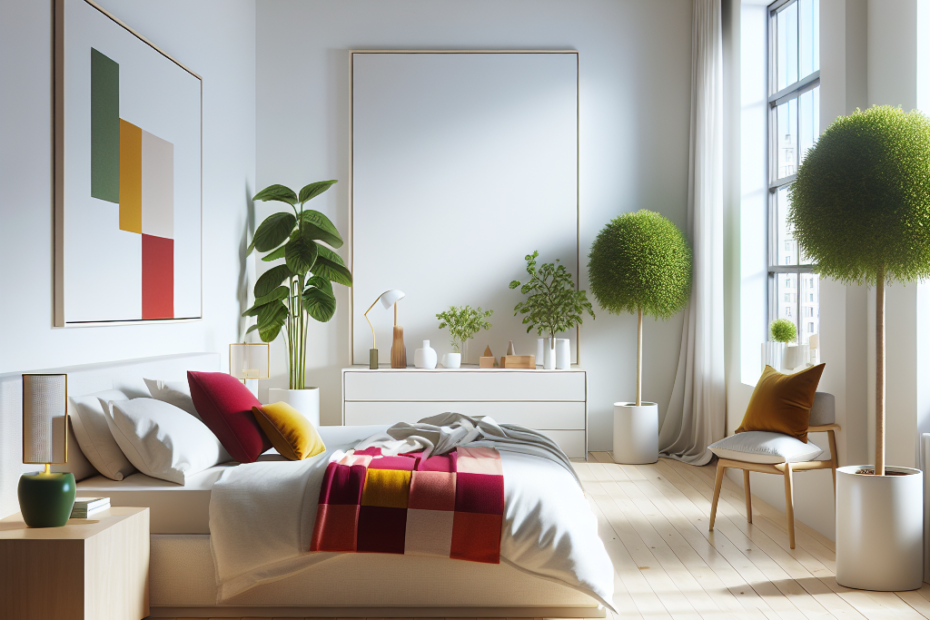“`html
Many people are drawn to the calming environment of a minimalist bedroom. The concept of minimalism, which embraces simplicity and functionality, has been a popular trend in home decor. According to a study by Statista, minimalism was one of the top five interior design trends in 2023 (Statista, 2023). Although minimalist designs are often associated with neutral and monochromatic palettes, incorporating subtle pops of color can add personality and warmth to a space.
The Essence of Minimalism
Minimalism focuses on the essentials, removing unnecessary clutter to create a clean and organized living space. A minimalist bedroom is characterized by simple furniture, unobtrusive lines, and a serene color palette. This simplicity isn’t just aesthetically pleasing but can also promote a sense of tranquility and peace. For those who desire a minimalist sanctuary, introducing subtle pops of color can be a gentle way to express individuality without compromising the calming essence of minimalism.
Balancing Neutral and Bold Colors
One of the fundamental aspects of a minimalist bedroom with pops of color is balance. They can start with a neutral base—whites, beiges, and grays—and then carefully integrate small doses of color through accent pieces. This approach maintains the room’s peaceful ambiance while adding visual interest.
| Color Technique | Elements to Use |
|---|---|
| Accent Walls | Paint one wall in a soft pastel or gentle gray-blue for contrast. |
| Bedding Accessories | Pillows or throws in colors like muted pinks, sea greens, or mustard tones. |
| Art and Decor | Small artworks or vases with subtle hues to complement neutral tones. |
Color Psychology in a Minimalist Setting
Colors can impact mood and energy, making their selection significant in bedroom styling. Blue hues are known to be calming, promoting restfulness. Yellows can energize and bring warmth, while greens have a refreshing effect. Carefully choose colors that complement the minimalist palette and enhance the desired atmosphere.
Statement Pieces
Introduce bold colors through statement pieces such as a single brightly colored chair or vibrant artwork. These elements can serve as focal points, drawing attention without overwhelming the simplicity of the overall design. It’s important that these pieces are in harmony with the existing decor to ensure a cohesive look.
Nature-Inspired Pops of Color
Add elements from nature such as indoor plants or floral arrangements to introduce color and texture. According to a report by NASA, houseplants can improve indoor air quality by filtering out pollutants (NASA, 1989). Including plants is a healthy way to add organic color to a minimalist bedroom.
Lighting and Fixtures
Lighting plays a crucial role in accentuating color. Soft, warm lighting can enhance subtle colors and create an inviting atmosphere. Consider fixtures with colored lampshades or ambient light settings to bring additional depth and interest to the space.
Key Takeaways
- Balance is key when integrating colors into a minimalist setting.
- Use neutral tones as a base and add subtle colors through accents.
- Consider the psychological effects of colors when choosing them.
- Statement pieces can add bold colors without overwhelming the space.
- Nature-inspired elements like plants can introduce texture and vibrancy.
FAQ
- Q1: What are the best colors to add to a minimalist bedroom?
- A1: Consider using soft pastels, muted tones of green, pink, or mustard for subtlety.
- Q2: How do colors affect mood in a bedroom?
- A2: Colors like blue promote calmness, yellow brings energy, and green provides refreshment.
- Q3: Should they paint an entire wall when adding color?
- A3: It’s advisable to use accent techniques, like painting a single wall or using colored decor.
- Q4: Are plants suitable for minimalist bedrooms?
- A4: Yes, plants add color and improve air quality, complementing minimalist designs.
- Q5: What role does lighting play in a minimalist bedroom?
- A5: Lighting enhances colors and mood, use soft lighting to highlight accent colors.
“`
